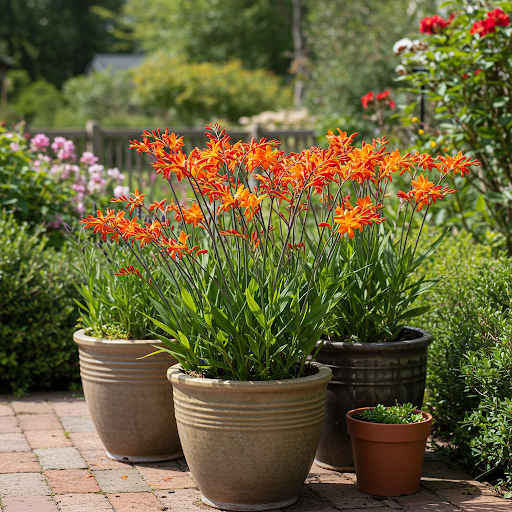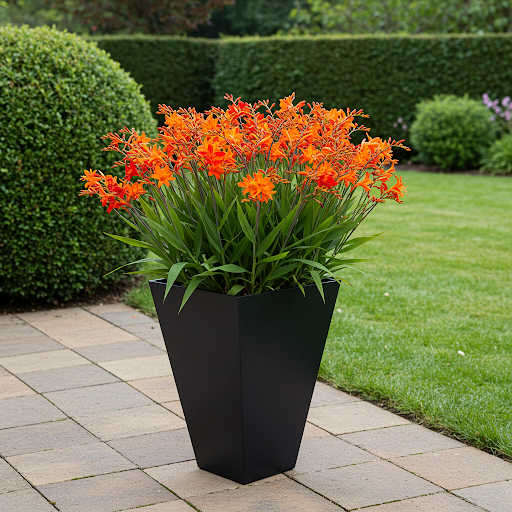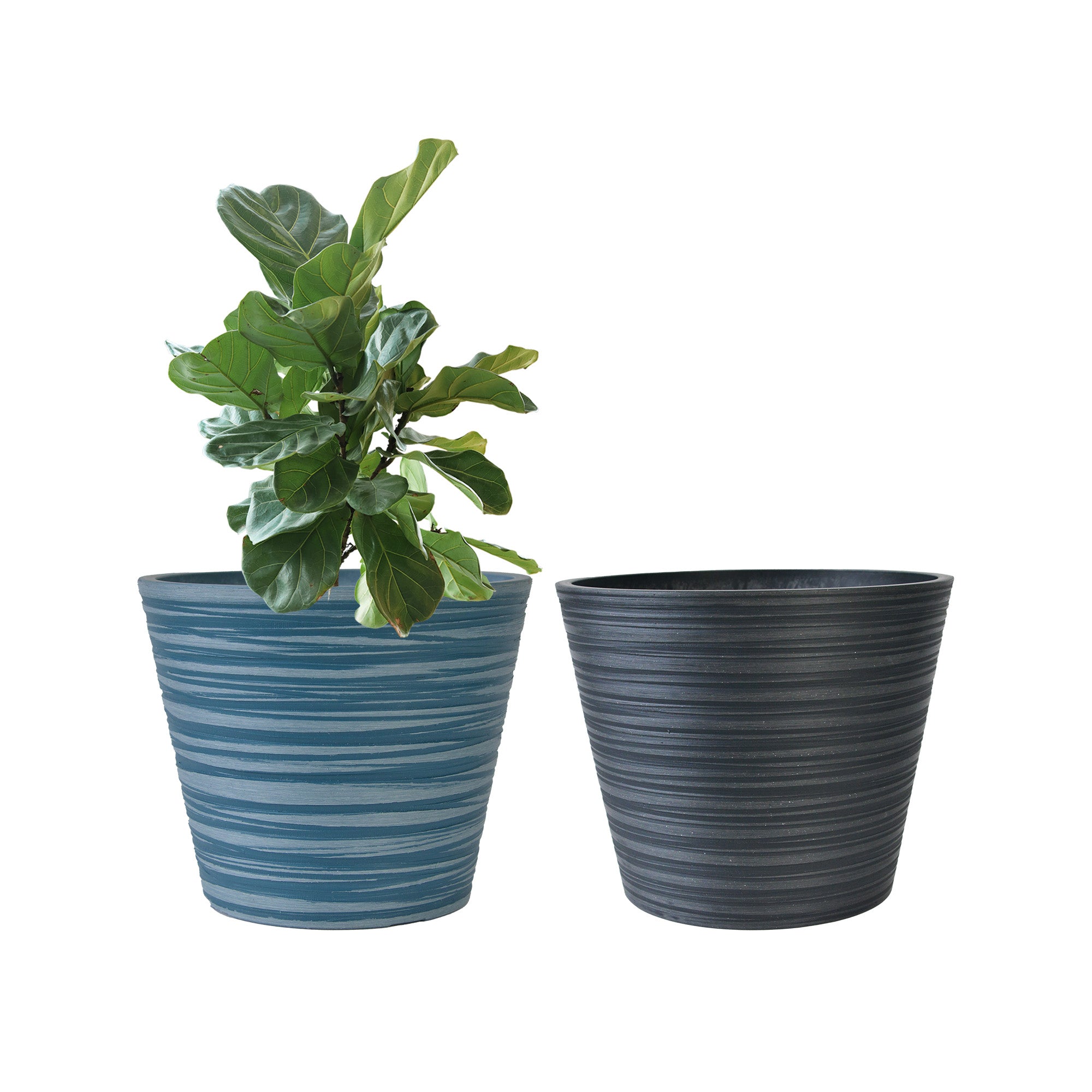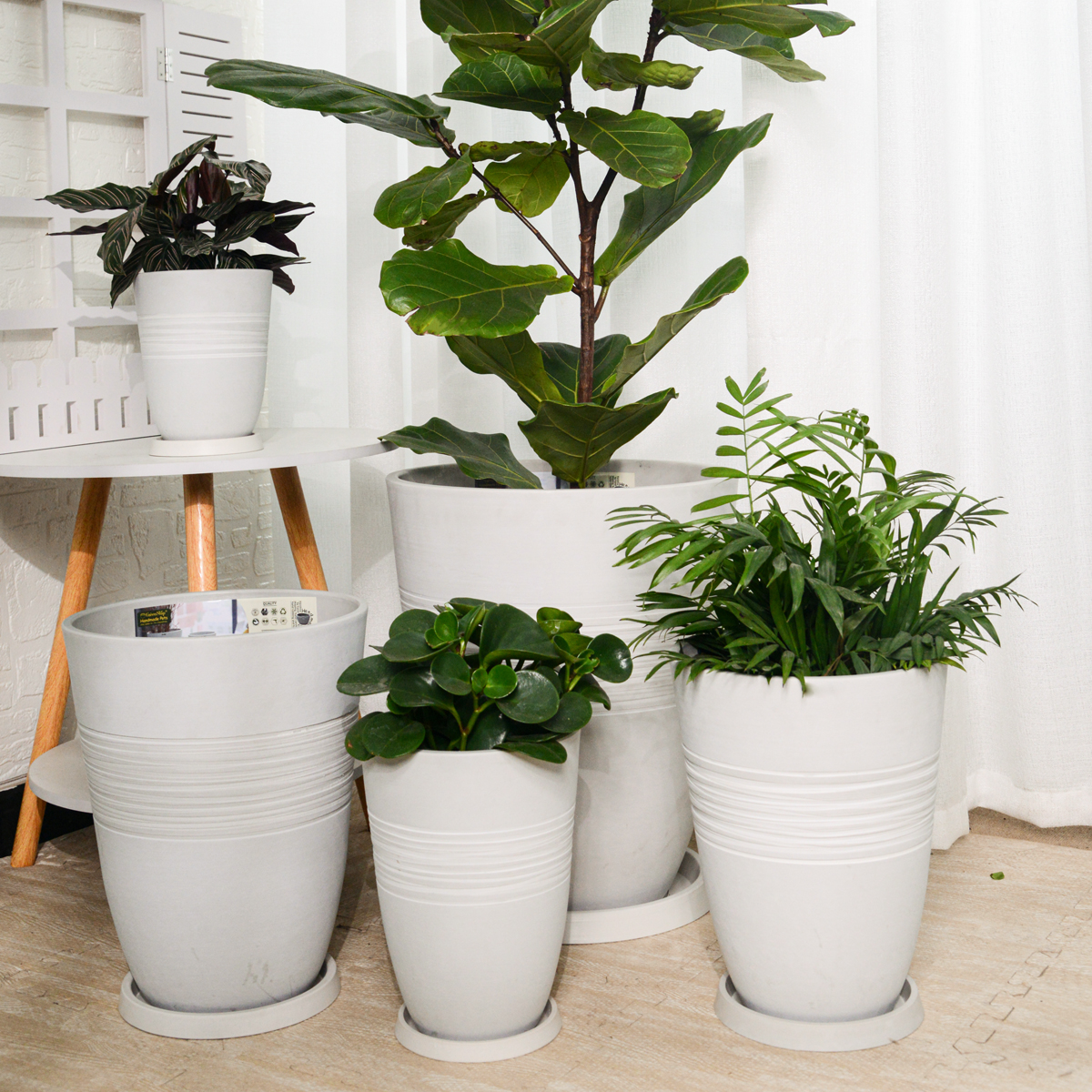Crocosmia in Pots: The Ultimate Guide to Growing Fiery Crocosmia Outdoors in Containers
Want to ignite your patio, balcony, or garden with dazzling, flame-like blooms that attract hummingbirds? , also known as Montbretia, are wonderfully vibrant and rewarding choices for outdoor container gardening. Celebrated for their fiery flower colors ranging from brilliant oranges and reds to sunny yellows, their sword-like foliage, and their ability to attract hummingbirds and butterflies, Crocosmia are perfect for adding a burst of summer heat to sunny outdoor spaces. This comprehensive guide will provide you with everything you need to know to grow Crocosmia successfully in outdoor pots, from selecting the best varieties and containers to mastering essential care techniques for a season filled with Crocosmia fire.

Montbretia
What are Crocosmia (Montbretia)?
Crocosmia, often called Crocosmia or Montbretia, is a genus of flowering plants in the Iridaceae family (iris family). Native to South Africa, Crocosmia are popular bulbous perennials grown for their vibrant, fiery-colored flowers and sword-like foliage. Crocosmia flowers are famous for their brilliant, warm colors and arching sprays of trumpet-shaped blooms that resemble miniature gladiolus or freesias. They come in a range of hot colors, including orange, red, yellow, and bi-colors, often with contrasting throats or markings. Crocosmia plants are characterized by their upright, sword-shaped leaves that resemble gladiolus foliage, adding a grassy texture to gardens and containers. They exhibit a clumping, upright growth habit, ranging in height from dwarf varieties under 1 foot to taller types over 3 feet tall, depending on the cultivar. They are known for their fiery colors, attractive foliage, long blooming season (summer to fall), sun-loving nature, and strong attraction to hummingbirds and butterflies, making them an invaluable addition to gardens and containers, especially for adding a burst of summer heat and attracting wildlife.
Are Crocosmia Good for Outdoor Pots?
Yes, Crocosmia are exceptionally well-suited for outdoor pots and container gardening, especially dwarf and medium-sized varieties. Their upright, clumping growth habit, relatively long blooming season, tolerance of sunny locations, and vibrant, fiery flowers make them ideal for filling pots, patio containers, and mixed container arrangements with summer excitement. Crocosmia thrive in sunny locations and bloom profusely throughout the warm season, providing a long-lasting and dazzling display in containers. Their relatively easy-care nature and striking, hummingbird-attracting blooms make them a fantastic and rewarding choice for container gardens of all styles, especially for adding a bold, warm-toned touch to patios, balconies, and decks. Growing Crocosmia in pots also allows you to easily move them to optimal locations to enjoy their beauty, to protect them from harsh winter conditions in colder climates, and to control their growing conditions, especially soil drainage which they appreciate.
Ideal Growing Conditions for Crocosmia in Pots:
Types of Crocosmia for Pots: Many Crocosmia varieties are excellent for pots, but consider your desired height, flower color, and bloom time when choosing:
- Dwarf Crocosmia: (Under 1.5 feet tall) – Compact and smaller in stature, ideal for small to medium pots, window boxes, and foreground plantings. Known for their very compact habit and profusion of blooms on shorter stems. Excellent for smaller containers and tighter spaces. Look for varieties in the ‘Lucifer’ (though technically medium, can work in larger pots), ‘George Davison’, ‘Emily McKenzie’, ‘Star of the East’ (smaller selections), and Crocosmia masoniorum ‘ ছোট জ্যাক’.
- Medium-Sized Crocosmia: (1.5-2.5 feet tall) – Bushy and more upright, but still manageable for containers, suitable for medium to large pots, patio containers, and as thrillers in mixed arrangements. Offer a good balance of height and flower power in pots. Look for varieties in the ‘Lucifer’ (classic, fiery red-orange), ‘ ক্যালifornিয়া Sunset’, ‘ Sungold’, ‘ Norwich Canary’, ‘ Honeycomb’, and ‘ অ্যাড니스’.
- Taller Crocosmia (for larger pots): (Over 2.5 feet tall) – Taller varieties can be grown in very large pots or tubs, but may require staking. Best suited for large patio containers, as back-of-border plants in very large mixed arrangements, or as dramatic focal points in spacious areas. Offer a more dramatic vertical presence and larger flower sprays. Look for varieties like ‘ Джексон Firebird’, ‘ স্প্যানিশ Flag’, ‘ Paul Gauguin’, and ‘ Citronella’. For most container gardening, dwarf to medium types are more practical.
- Color Themes (for Pots): Choose varieties based on your desired color palette for your container garden.
- Fiery Oranges & Reds: ‘Lucifer’ (classic red-orange), ‘ ক্যালifornিয়া Sunset’ (orange-red blend), ‘ Джекসন Firebird’ (fiery red), ‘ Индия Summer’ (bright orange), ‘ Vulcan’ (deep red).
- Sunny Yellows & Golds: ‘Sungold’ (golden yellow), ‘ Norwich Canary’ (canary yellow), ‘ Citronella’ (lemon yellow), ‘ Moonlight’ (pale yellow), ‘ Jenny Bloom’ (soft yellow).
- Apricot & Peach Tones: ‘ অ্যাড니스’ (apricot-orange), ‘ Emily McKenzie’ (apricot-orange with red eye), ‘ Star of the East’ (apricot-orange, smaller size), ‘ Honeycomb’ (apricot-yellow bicolor).
- Bi-colors & Unusual Shades: ‘ স্প্যানিশ Flag’ (red and yellow bicolor), ‘ Paul Gauguin’ (orange with red streaks), ‘ George Davison’ (orange with red throat).
Light: Crocosmia thrive in full sun. They need at least 6-8 hours of direct sunlight per day to bloom profusely and develop their best flower colors. Choose a sunny location for your Crocosmia containers, such as a south-facing patio, balcony, or garden bed. In partial shade, Crocosmia may still bloom, but flower production will be reduced, and stems may become weaker and leggy. Full sun is essential for optimal flowering, vibrant colors, and robust growth.
Soil: Crocosmia need well-draining soil that is moderately fertile and slightly acidic to neutral. Use a high-quality potting mix specifically formulated for containers or flowers. Amend potting mix with perlite, vermiculite, or horticultural grit to improve drainage and aeration, which is important for Crocosmia bulbs (corms) to prevent rot. Crocosmia prefer soil that retains some moisture but is not soggy. Avoid heavy, compacted soil or garden soil in pots, as they can become waterlogged. A slightly acidic to neutral pH (around 6.0-7.0) is ideal for Crocosmia.
Watering: Crocosmia prefer moderately moist soil during their growing and blooming season. Water thoroughly when the top inch of soil feels dry. Water deeply until water drains out of the drainage holes. Allow the soil surface to dry out slightly between waterings. Avoid overwatering and constantly wet soil, especially during their dormant period in winter. Watering frequency will depend on weather conditions, light levels, pot size, and plant size. During hot, sunny, or windy weather, you may need to water more frequently, especially for pots in full sun. Check soil moisture regularly and adjust watering accordingly. Reduce watering in late summer as foliage starts to die back and plants prepare for dormancy. Water sparingly in winter if pots are kept in a sheltered, frost-free location, just enough to prevent complete drying out of the soil.
Temperature: Crocosmia are relatively hardy plants that tolerate a range of temperatures. They are generally hardy perennials in USDA zones 6-9, and sometimes zone 5 with protection. They perform best in moderate summer temperatures between 65°F to 80°F (18°C to 27°C). They can tolerate heat, but prolonged high temperatures above 85°F (29°C) can shorten bloom time. Crocosmia are frost-hardy and can tolerate light frosts, but potted plants need protection from hard freezes, especially in colder zones. Potted Crocosmia can be overwintered outdoors in zones 6-9 with protection, or moved to a sheltered, frost-free location in colder zones.
Fertilizer: Crocosmia are moderate feeders and benefit from moderate fertilization to support their blooming season and healthy growth. Over-fertilizing can lead to leggy growth and weak stems. Fertilize sparingly to moderately during the growing season (spring to late summer) with a balanced liquid fertilizer (e.g., 10-10-10 or 20-20-20) diluted to half strength, every 4-6 weeks. Alternatively, you can use a slow-release granular fertilizerincorporated into the potting mix at planting time, but use it at a lower rate than recommended for heavy feeders. Avoid high-nitrogen fertilizers, which can promote leafy growth at the expense of blooms. Bone meal or a fertilizer slightly higher in phosphorus can encourage better flowering. Cease fertilizing in late summer as plants prepare for dormancy.
Choosing the Right Pots for Crocosmia:
Suitable Pot Types: Crocosmia are adaptable to various pot types, but terracotta and other well-draining pots are recommended due to their need for good drainage. Consider these factors when selecting pot types for Crocosmia:
- Terracotta Pots: Porous, allow excellent aeration and drainage, and aesthetically natural and warm-toned, complementing Crocosmia’s fiery colors. Terracotta is a good choice for Crocosmia as it helps prevent overwatering and promotes good bulb health. Terracotta pots also dry out more quickly, which is generally beneficial for Crocosmia, helping to avoid soggy soil. Monitor soil moisture and water as needed.
- Unglazed Ceramic Pots: Similar to terracotta, unglazed ceramic pots offer good aeration and drainage. Choose unglazed ceramic over glazed for better breathability.
- Plastic or Resin Pots (with caution): Plastic and resin pots retain moisture much more than terracotta, which can be problematic for Crocosmia if overwatered. If using plastic or resin pots, ensure excellent drainage holes, and be extra careful with watering, allowing the soil to dry out more between waterings. Amend potting mix aggressively with perlite or grit to improve drainage when using plastic pots. Lighter colored plastic pots may heat up less in direct sun.
- Avoid Deep, Water-Retaining Pots: Crocosmia prefer shallower to medium-depth pots and dislike constantly wet feet. Avoid very deep pots or pots without drainage holes that can lead to waterlogged soil and bulb rot.
Drainage: Excellent drainage is essential for Crocosmia to prevent bulb rot and ensure healthy growth and flowering. Ensure your chosen pot has large and ample drainage holes at the bottom. Avoid pots without drainage holes. Adding a generous layer of drainage material at the base of the pot is highly recommended, such as a 2-3 inch layer of gravel, perlite, horticultural grit, or pot shards to further improve drainage, especially in heavier pots or when using plastic pots. Elevating pots slightly on pot feet or bricks can further improve drainage and air circulation around the base.
Pot Size: Choose pot sizes appropriate for the type and mature size of the Crocosmia you are planting, and the desired display. Crocosmia bulbs (corms) multiply over time, so allow some room for growth.
- Dwarf Crocosmia: For dwarf Crocosmia, pots that are 6-8 inches in diameter and at least 6 inches deep are suitable for planting 3-5 bulbs per pot. For mass plantings or window boxes, use larger containers or window boxes with spacing of about 3-4 inches between bulbs.
- Medium-Sized Crocosmia: For medium-sized Crocosmia varieties, use pots that are 8-12 inches in diameterand at least 8-10 inches deep for planting 3-5 bulbs per pot. For fuller displays or mixed plantings, use pots that are 12-16 inches or larger, or larger tubs, spacing bulbs about 4-6 inches apart.
- Taller Crocosmia (for larger pots): For taller Crocosmia varieties, use very large pots or tubs that are at least 14-16 inches in diameter or larger and at least 12-14 inches deep for planting 3-5 bulbs, spacing bulbs about 6-8 inches apart. Taller Cannas need more root space and stability.
Color and Style: Choose pot colors and styles that complement your Crocosmia blooms and your outdoor décor. Earthy tones, terracotta, rustic wood, or metal pots can enhance the natural, fiery beauty of Crocosmia. Boldly colored pots in blues, greens, or purples can provide a striking contrast to orange, red, and yellow Crocosmia blooms. Terra cotta pots offer a classic, Mediterranean or cottage garden style that complements Crocosmia’s natural look. Consider the overall style of your patio or garden and choose pots that harmonize with the surroundings, and enhance the warm, vibrant ambiance you wish to create.
Essential Care Tips for Thriving Crocosmia in Outdoor Pots:
- Watering: “Water When Top Inch of Soil is Dry, Avoid Overwatering”. Water thoroughly when the top inch of soil feels slightly dry. Water deeply until water drains from drainage holes. Allow soil surface to dry slightly between waterings. Avoid overwatering and soggy soil. Reduce watering in late summer and sparingly in winter dormancy.
- Sunlight: Provide Full Sun (6-8+ Hours Daily). Place Crocosmia pots in a location that receives full sun for best blooming and vibrant colors.
- Fertilizing: Fertilize Sparingly to Moderately, Every 4-6 Weeks During Growing Season. Fertilize every 4-6 weeks with a dilute balanced liquid fertilizer, or use slow-release fertilizer at planting time at a lower rate. Avoid over-fertilizing.
- Deadheading (Optional, For Tidiness): Deadheading spent flower stalks is not strictly necessary for Crocosmia to rebloom, but you can remove faded flower stalks for a tidier appearance and to prevent seed formation (if desired). Snip off faded flower stalks at the base.
- Foliage Care (Allow Foliage to Die Back Naturally): Allow Crocosmia foliage to die back naturally in late summer or fall after blooming. Do not cut back green foliage, as it helps to nourish the bulbs for next year’s growth. Once foliage has completely yellowed and dried, you can trim it back to the base.
- Overwintering (Protect from Hard Freezes in Cold Climates): In colder USDA zones (below zone 6), potted Crocosmia need to be overwintered in a sheltered, frost-free location to protect the bulbs from freezing. Before the first hard frost, cut back foliage to a few inches above the soil line. Move pots to a cool, dry, dark location, such as an unheated garage, basement, or shed. In zones 6-7, you may be able to overwinter pots outdoors in a sheltered location with heavy mulching around the base and pot insulation. In zones 8-9, potted Crocosmia can generally overwinter outdoors with minimal protection. Reduce watering significantly during winter dormancy, just enough to prevent complete drying out of the soil. In spring, when new growth emerges, gradually acclimate pots back to outdoor conditions.
- Dividing (Every 3-4 Years, Optional): Crocosmia bulbs (corms) multiply over time, and clumps can become overcrowded every 3-4 years. Division is optional, but can help prevent overcrowding and rejuvenate plants. Divide clumps in spring or fall when repotting. Dig up the clump, gently separate the bulbs (corms), and replant in fresh potting mix, spacing them adequately. Division is not strictly necessary for container Crocosmia as they are somewhat contained, but can be done if pots become very crowded.
- Pest and Disease Control: Crocosmia are generally relatively pest and disease-resistant. Monitor for occasional pests like spider mites or aphids. Bulb rot can occur in poorly drained soil or overly wet conditions. Ensure excellent drainage and avoid overwatering to prevent bulb rot. Deer and rabbits generally tend to avoid Crocosmia.
Popular Crocosmia Cultivars for Pots (by Type/Color/Height):
- Dwarf Crocosmia: ‘ ছোট Джек’ (C. masoniorum dwarf, orange, compact), ‘Emily McKenzie’ (apricot-orange, dwarf, early blooming), ‘George Davison’ (orange-red, dwarf, compact), ‘Star of the East’ (apricot-orange, smaller selections available)
- Medium Crocosmia: ‘Lucifer’ (fiery red-orange, classic, medium height), ‘ ক্যালifornিয়া Sunset’ (orange-red blend, medium, sunset colors), ‘Sungold’ (golden yellow, medium, sunny), ‘ Norwich Canary’ (canary yellow, medium, bright yellow), ‘ Honeycomb’ (apricot-yellow bicolor, medium, unique colors), ‘ অ্যাড니스’ (apricot-orange, medium, soft tones)
- Taller Crocosmia (for larger pots): ‘ Джексон Firebird’ (fiery red, tall, dramatic), ‘ স্প্যানিশ Flag’ (red and yellow bicolor, tall, striking), ‘ Paul Gauguin’ (orange with red streaks, tall, patterned blooms), ‘ Citronella’ (lemon yellow, tall, elegant), ‘ Babylon’ (orange-red, very tall, back of border)
- Color Themes (Examples):
- Fiery Red/Orange: ‘Lucifer’, ‘ Джексон Firebird’, ‘ Vulcan’, ‘ Fire King’, ‘ Red Molten Fire’.
- Sunny Yellow/Gold: ‘Sungold’, ‘ Norwich Canary’, ‘ Citronella’, ‘ Moonlight’, ‘ Canary Dance’.
- Apricot/Peach: ‘ অ্যাড니스’, ‘ Emily McKenzie’, ‘ Star of the East’, ‘ Tangerine Queen’, ‘ Apricot Dream’.
- Bi-color/Unique: ‘ স্প্যানিশ Flag’, ‘ Paul Gauguin’, ‘ George Davison’, ‘ Twilight Fairy’, ‘ Prince of Orange’.
- Seed Mixes (Less Common for Hybrids): Crocosmia are typically propagated by bulbs (corms), and seed mixes are less common for named hybrid cultivars. Seed-grown Crocosmia may be less predictable in flower color and form, and may take longer to bloom.
In Summary:
Growing Crocosmia in outdoor pots is a wonderfully rewarding way to add a burst of fiery color and attract hummingbirds and butterflies to your patios, balconies, and gardens. Their vibrant blooms, attractive foliage, long blooming season, adaptability to sunny locations, and relatively easy-care nature (especially with well-draining soil and moderate watering) make them a perfect choice for container gardeners seeking dazzling, summer-blooming plants. By providing full sun, well-draining potting mix in pots with drainage, watering appropriately and avoiding overwatering, fertilizing sparingly to moderately during the growing season, deadheading spent flowers (optional), and protecting bulbs from hard freezes in colder climates, you can easily cultivate thriving Crocosmia plants in pots and enjoy their captivating fiery beauty from summer until fall, year after year as perennial bulbs.

Montbretia
For more detailed botanical information and to explore the diverse world of Crocosmia species and cultivars, you can visit the Wikipedia page on Crocosmia.
Important Note: Crocosmia plants are generally considered non-toxic to humans and pets, making them a safe and attractive choice for households with children and animals. The primary care benefits of Crocosmia in pots are their exceptionally vibrant and fiery flower colors, attractive sword-like foliage, and strong attraction to hummingbirds and butterflies, bringing a dynamic and exciting element to your outdoor spaces for many months. With these simple care practices, you can enjoy a season filled with the dazzling beauty of Crocosmia in your outdoor containers.
Modern Plant Pots丨Planter for Indoor Plants,8 inch or 10 inch Plant Pots with Drainage Hole,Decorative Flower Pots
By greenship-seo|2025-04-10T08:32:55+00:00January 7, 2025|Categories: Hand-carving Series|Tags: Decorative Flower Pots, Self-Watering Pots|
HS
By greenship|2024-08-13T06:45:17+00:00August 13, 2024|Categories: Hand-carving Series|
Planter 5 in W / 8 in W / 12 in W or Indoor Outdoor Plants, Modern Decorative Plant Pots with Drainage Hole, Decorative Flower Pots
By greenship-seo|2025-04-10T06:37:58+00:00January 16, 2025|Categories: Hand-carving Series|Tags: Decorative Flower Pots|
KC2-11V
By greenship|2024-08-16T05:39:50+00:00August 16, 2024|Categories: Hand-carving Series|
11TH
By greenship|2024-08-13T02:50:25+00:00August 13, 2024|Categories: Hand-carving Series|
KC2-11VH
By greenship|2024-08-16T06:19:28+00:00August 16, 2024|Categories: Hand-carving Series|






